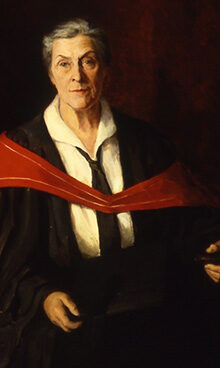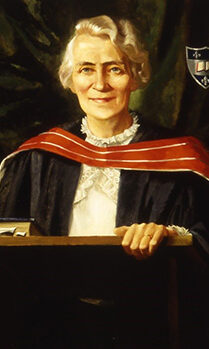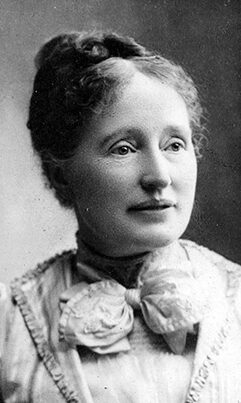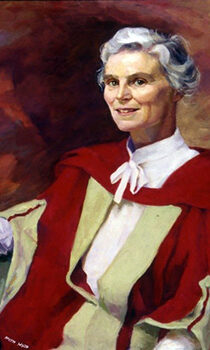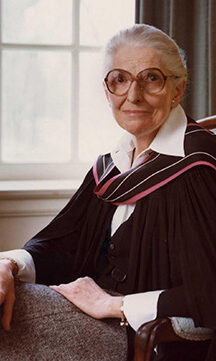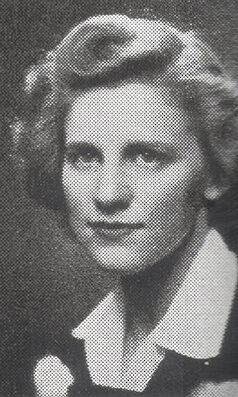Celebrating International Women’s Day 2024
To celebrate International Women’s Day, we’ve compiled stories about members of the Trinity community – from Provost Mayo Moran who served as the first female Dean of the Faculty of Law, and alumnae who were Canada’s first female lawyer and the first female to hold a doctorate in computer science, to the College’s first tenured woman faculty member and women leaders of St. Hilda’s College. These incredible trailblazers are an inspiring reminder of what has been accomplished, and what is left still to do.
The United Nations officially recognized International Women’s Day (IWD) in 1977. While recognizing the many achievements of women and girls, the IWD is an opportunity to amplify the achievements of women while recognizing that gender parity is still a distant goal. The theme of this year’s International Women’s Day is ‘Inspire Inclusion’.
CELEBRATING MEMBERS OF THE TRINITY COMMUNITY
- 2024 | Mayo Moran: First female Dean of the Faculty of Law, University of Toronto
- Elizabeth Benn: Sports Trailblazer
- Myrtle Burgess: First Female Black Student to Study at Trinity
- Gloria Carpenter: Pioneer Who Helped Bring Legal Change to the Caribbean
- Helen Gregory: In 1884, Helen Gregory was the first woman admitted to Trinity College
- Marsha Hewitt: First Dean of Divinity (acting) since the establishment of the Faculty
- Clara Martin: Canada’s First Woman Lawyer
- Ethel Ridley: Matron-in-Chief of the Canadian Nursing Staff during the First World War
- Audrey Tobias: From Quiet Protester to Front Page News
- Caroline Louise Josephine Wells: First Women Dentist in Canada
- Beatrice Worsley: Canada’s First Female Computer Scientist
- St. Hilda’s College: Elizabeth Abbott | Mabel Cartwright | Mossie May (Waddington) Kirkwood | Ellen (Patteson) Rigby | The Rev. Elizabeth Maude (Hunter) Rowlinson | Melinda Hartnet Seaman | Mary Stedman
Mayo Moran – First female Dean of the Faculty of Law
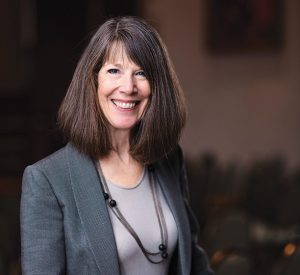 Professor Mayo Moran was appointed as the 15th Provost & Vice-Chancellor of Trinity College on July 1, 2014. Prior to assuming her role as Provost, Professor Moran served as the first female Dean of the Faculty of Law at the University of Toronto. Provost Moran publishes extensively on comparative constitutional law, legal and feminist theory, and historical injustices among other topics. Her book Rethinking the Reasonable Person (Oxford University Press) examines how judicial ideas of “normal” behaviour may discriminate against women and girls. Her latest book, The Problem of the Past and How to Fix It, is forthcoming from Oxford University Press.
Professor Mayo Moran was appointed as the 15th Provost & Vice-Chancellor of Trinity College on July 1, 2014. Prior to assuming her role as Provost, Professor Moran served as the first female Dean of the Faculty of Law at the University of Toronto. Provost Moran publishes extensively on comparative constitutional law, legal and feminist theory, and historical injustices among other topics. Her book Rethinking the Reasonable Person (Oxford University Press) examines how judicial ideas of “normal” behaviour may discriminate against women and girls. Her latest book, The Problem of the Past and How to Fix It, is forthcoming from Oxford University Press.
Provost Moran will speak at the University Faculty Women’s Club luncheon in celebration of International Women’s Day on March 8, 2024. Provost Moran shares the theme of her IWD talk: “I teach a course called Ten Cases that Changed the World. For International Women’s Day, I decided to take up that theme and to tell the stories of a few women who faced terrible injustice and who had the courage to fight against the odds so that others wouldn’t face what they did. We tend to think that people who change the world are endowed with extraordinary powers, but these women show how despite all odds, ordinary people sometimes change the course of history. For that reason, I am calling the talk, “Ordinary Heroes: Three Women who Changed the World.”
Elizabeth Benn – Sports Trailblazer
 Trinity alumna Elizabeth Benn is at the top of her game.
Trinity alumna Elizabeth Benn is at the top of her game.
In February 2022, Elizabeth made history when she was named director of major-league operations for the New York Mets.
She’s the highest-ranking female baseball ops employee in franchise history, and one of a select few to break into the upper echelons of any big-league front office.
Read her inspirational story – including battling stereotypes and discrimination and determined perseverance – in the Toronto Star: from High Park to the Mets front office. This is how she got there.
Myrtle Burgess – First Female Black Student to Study at Trinity

In the early 1900s, Provost Thomas Macklem admitted three students to Trinity College and St. Hilda’s College, siblings from St. Louis, Missouri. However, unbeknownst to Provost Macklem when he made the offer of acceptance, the students were Black.
Myrtle was the College’s first female Black student, and her story offers us an important glimpse into life as a Black student at Trinity in the early 20th century.
It is a credit to her intelligence, drive and tenacity that even in the face of discrimination, she continued her studies. Read more about Myrtle’s life as a student and the story of the Burgess siblings.
In 2019, Trinity College named a student residence – Burgess House – in St. Hilda’s after our first female Black student, Myrtle Burgess.
Gloria Carpenter – Pioneer Who Helped Bring Legal Change to the Caribbean

Trinity alumnae Gloria Clare Carpenter went on to become the first Black woman to graduate from Cambridge. In the photo below, she stands in the back row, on the left, in the 1943 edition of Torontonensis (photo courtesy of University of Toronto Archives).
Carpenter, who died in 1995, completed her Bachelor of Arts in law at U of T and, at the end of the Second World War, left Toronto to become the first Black woman to graduate from the University of Cambridge, where she pursued advanced legal studies. Read more about her story and how she paved the way for future generations.
Helen Gregory – The first woman admitted to Trinity College in 1884, Helen Gregory was a pioneering journalist, feminist and judge
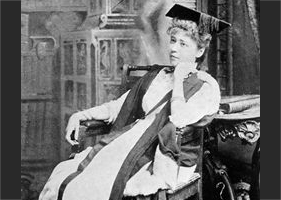 Helen Gregory MacGill (nee Helen Emma Gregory: 1864 to 1947) – women’s rights activist and magistrate. She was the first woman admitted to Trinity College in 1884 and the first woman to graduate from the College (BA, MA). As a reporter, she travelled alone across the Canadian West to Japan. She later served for 23 years as judge of the Vancouver Juvenile Court. She was the first woman appointed judge in the region (1917) and the third in Canada. Learn more about Helen’s life – women’s rights activist and magistrate.
Helen Gregory MacGill (nee Helen Emma Gregory: 1864 to 1947) – women’s rights activist and magistrate. She was the first woman admitted to Trinity College in 1884 and the first woman to graduate from the College (BA, MA). As a reporter, she travelled alone across the Canadian West to Japan. She later served for 23 years as judge of the Vancouver Juvenile Court. She was the first woman appointed judge in the region (1917) and the third in Canada. Learn more about Helen’s life – women’s rights activist and magistrate.
Marsha Hewitt – First Dean of Divinity since the establishment of the Faculty
 Meet Marsha Hewitt: for the 2022-2023 academic year, Professor Hewitt is the Acting Dean of the Faculty of Divinity. She was the first full-time, tenured woman faculty member in the Faculty and the first woman to hold the Dean role since the establishment of the Faculty over 170 years ago. Professor Hewitt is also a member of the Department for the Study of Religion at the University of Toronto.
Meet Marsha Hewitt: for the 2022-2023 academic year, Professor Hewitt is the Acting Dean of the Faculty of Divinity. She was the first full-time, tenured woman faculty member in the Faculty and the first woman to hold the Dean role since the establishment of the Faculty over 170 years ago. Professor Hewitt is also a member of the Department for the Study of Religion at the University of Toronto.
Now entering her 36th year at Trinity, she teaches undergraduate and graduate courses in psychoanalytic theory and clinical practice, psychoanalytic psychology of religion, dreams and visions, critical theory and method and theory in the study of religion. “Teaching is my vocation, and I choose that word carefully. I am happiest when teaching: we have wonderful, intelligent and interesting students at both Trinity College and the University of Toronto. It has always been, and remains for me, a pleasure and a privilege to work with them,” Professor Hewitt said. Last year, she also contributed to Windvane – an online guide for well-being for students and instructors in higher education: “Among a variety of topics, she talks about how the COVID-19 pandemic has traumatized us on a global scale, and how ‘now more than ever, it is important for educators to show deep care for their students.’”
You can learn more about Professor Hewitt in the “Meet Faculty & Staff Initiative” produced by Trinity’s Wellness Team.
Clara Martin – Canada’s First Woman Lawyer
 When Clara Martin was a law student living in a Toronto boarding house, a young male resident denounced her as a “very odd sort of woman.” His observation seemed to rest on her penchant for riding a bicycle – eyebrow-raising behaviour for a well-bred lady in the late 1800s. This wasn’t her first, or last, act of social impropriety, however. Martin – who graduated with a math degree in 1890 and a bachelor of civil law degree in 1897 from Trinity College, and an LLB in 1899 from U of T – succeeded in becoming the first woman lawyer in the British Empire. Her road was often a difficult, lonely one. “I was looked upon as an interloper, if not a curiosity,” said Martin of her articling days at a Toronto law firm. “The clerks avoided me and made it as unpleasant for me as they possibly could.”
When Clara Martin was a law student living in a Toronto boarding house, a young male resident denounced her as a “very odd sort of woman.” His observation seemed to rest on her penchant for riding a bicycle – eyebrow-raising behaviour for a well-bred lady in the late 1800s. This wasn’t her first, or last, act of social impropriety, however. Martin – who graduated with a math degree in 1890 and a bachelor of civil law degree in 1897 from Trinity College, and an LLB in 1899 from U of T – succeeded in becoming the first woman lawyer in the British Empire. Her road was often a difficult, lonely one. “I was looked upon as an interloper, if not a curiosity,” said Martin of her articling days at a Toronto law firm. “The clerks avoided me and made it as unpleasant for me as they possibly could.”
Martin was also the first female student at Osgoode Hall Law School. In 1891, the Law Society of Upper Canada had informed her that admission to Osgoode was restricted to “persons” – and under the British North America Act, women did not qualify as such. With the help of Oliver Mowat, premier and attorney-general of Ontario, Martin galvanized the legislature into passing an 1892 act granting women access to the law school. She entered Osgoode the following year and was called to the Bar of Ontario in February 1897.
After working as a law clerk at two Toronto firms, Martin opened her own private practice. In 1923, at the age of 49, she died of a heart attack. Recalling her difficult path, and the stoicism of her early student years, Martin once said, “Were it not that I set out to open the way to the bar for others of my sex, I would have given up the effort long ago.” Read more about other incredible ‘firsts’ for women at the university in U of T Magazine.
Ethel Ridley – Matron-in-Chief of the Canadian Nursing Staff during the First World War
 Ethel Ridley (1872 – 1949) graduated from Trinity College in 1895. She enlisted as a nurse with the Canadian Army Medical Corps during the First World War and was stationed in military hospitals throughout England and France, eventually becoming Matron-in-Chief of the Canadian nursing staff.
Ethel Ridley (1872 – 1949) graduated from Trinity College in 1895. She enlisted as a nurse with the Canadian Army Medical Corps during the First World War and was stationed in military hospitals throughout England and France, eventually becoming Matron-in-Chief of the Canadian nursing staff.
She received commendations for her service, including the Royal Red Cross in 1916 and the Order of the British Empire in 1918. Following the war, she returned to the New York Orthopaedic Hospital as Directress of Nurses.
The photographs and postcards document various stages of her life, from her time as a student at St. Hilda’s College through to her retirement in Gananoque.
[Source: Trinity College Archives F2115: From the Archives]
Audrey Tobias – From Quiet Protester to Front Page News
 Trinity alumna (Class of 1948) Audrey Tobias (1924 – 2016) was an activist who made headlines when she was criminally charged for refusing to fill out the census.
Trinity alumna (Class of 1948) Audrey Tobias (1924 – 2016) was an activist who made headlines when she was criminally charged for refusing to fill out the census.
An inspiring example of a woman who stood up for that she believed in, her story was featured in the Toronto Star.
Caroline Louise Josephine Wells: First Woman Dentist in Canada
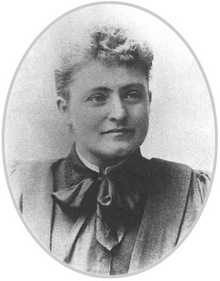 In 1893, Caroline Louise Josephine Wells (1856-1939) broke Ontario’s dentistry gender barrier as the first female member of the Ontario Dental Society and the first female graduate of the Royal College of Dental Surgeons (RCDS). Dr. Wells was married to a dentist and when his health started to fail, she decided to go into the profession. This was no easy feat, as she faced tremendous social and economic pressures to achieve her goal. Determined to overcome these obstacles, Wells sent her three children to live with relatives so that she could concentrate on her studies and successfully complete her education. She attended Trinity College and received her doctorate (DDS) in 1899 from the college’s Faculty of Dentistry. For 36 years, Dr. Wells practised in Toronto, providing groundbreaking dental care to patients – caring for this vulnerable and neglected population – in several of Ontario’s mental hospitals. She retired at the age of 72. (Sources: Ontario Dental Association and wikipedia)
In 1893, Caroline Louise Josephine Wells (1856-1939) broke Ontario’s dentistry gender barrier as the first female member of the Ontario Dental Society and the first female graduate of the Royal College of Dental Surgeons (RCDS). Dr. Wells was married to a dentist and when his health started to fail, she decided to go into the profession. This was no easy feat, as she faced tremendous social and economic pressures to achieve her goal. Determined to overcome these obstacles, Wells sent her three children to live with relatives so that she could concentrate on her studies and successfully complete her education. She attended Trinity College and received her doctorate (DDS) in 1899 from the college’s Faculty of Dentistry. For 36 years, Dr. Wells practised in Toronto, providing groundbreaking dental care to patients – caring for this vulnerable and neglected population – in several of Ontario’s mental hospitals. She retired at the age of 72. (Sources: Ontario Dental Association and wikipedia)
Beatrice Worsley – Canada’s First Female Computer Scientist

Beatrice Worsley, known to her friends and colleagues as Trixie, is believed to be both the first woman in the world to earn a doctorate in computer science and Canada’s first female computer scientist. She completed her undergraduate studies in mathematics and physics at U of T’s Trinity College in 1944, and soon afterwards enlisted in the Women’s Royal Canadian Naval Service.
For her doctoral studies in mathematical physics at Cambridge, she was supervised by computer science forerunners Maurice Wilkes and Alan Turing. Her dissertation, “Serial programming for real and idealized digital calculating machines” is considered the first on modern computing. This former assistant professor at U of T died at the age of 50 from a heart attack.
Read more about this trailblazer: Honouring Canada’s first female computer scientist: U of T’s Trixie Worsley and female U of T legends.
Learn about the scholarship Graduate Scholarship in Computer Science established in honour of Beatrice Worsley (1921–1972).
- Helen Gregory: In 1884, Helen Gregory was the first woman admitted to Trinity College
Celebrating Leaders of St. Hilda’s College
Who are the people behind the named rooms at St. Hilda’s College? They are inspiring and compassionate women, accomplished scholars and influential leaders. Admired and revered by the Trinity community and beyond, their many contributions have helped to shape who we are as a community today: Elizabeth Abbott, Mabel Cartwright, Mossie May (Waddington) Kirkwood, Ellen (Patteson) Rigby, The Rev. Elizabeth Maude (Hunter) Rowlinson, Melinda Hartnet Seaman, Mary Stedman. Learn about some of the incredible women of St. Hilda’s College who left a special mark within the historic spaces of the college.
The Abbott Room:
Elizabeth Abbott, MA, PhD (1942-) – Second Dean of St. Hilda’s College and Sixth Dean of Women Students at Trinity College, 1991-2004
In 1991, Abbott was installed as Trinity College’s Dean of Women and Dean of St. Hilda’s College, where she served for thirteen years until retiring in 2004 to become a full-time writer. During her deanship, Abbott, an advocate for social justice, was Trinity’s representative on the University of Toronto’s Committee on Homophobia, on the Editorial Board of the Canadian Human Rights Foundation, and on the Rights and Freedoms Committee of the Writers’ Union of Canada. She also served as an adviser to Trinity’s Latin American Club and, from 1992 to 1997, played defence for the Saints, the Trinity women’s ice hockey team. When Abbott retired, the former Dean’s Reception Room in St. Hilda’s was renamed The Abbott Room in her honour. In October 2017, the student wellness space opened in the Abbott Room with the room’s namesake Elizabeth Abbott in attendance at the welcome event.
Cartwright Hall:
Mabel Cartwright, BA, LLD (1869-1955) – Second Principal of St. Hilda’s College, 1903-1936 and First Dean of Women Students at Trinity College, 1915-1936
In 1903 she was appointed Principal of St. Hilda’s College and in 1915 she was granted the additional title of Dean of Women at Trinity College. Academically, Cartwright was Lecturer in English at Trinity College from 1916 until 1928, when she was promoted to Associate Professor of English. In 1925 she oversaw the move of St. Hilda’s College from Queen Street to three houses on St. George Street. Cartwright was determined to retain the old college traditions, but also continue to foster a strong and long-lasting sense of community and belonging among the Saints. She made sure to involve non-residents in the college’s activities and called for mandatory attendance at chapel and choir as well as active social service work by every student. Also in 1925, she was granted a Doctor of Laws (honoris causa) by the University of Toronto. When Cartwright retired in 1936, she was granted the title of Principal Emeritus. In November 1937 she laid the cornerstone for the new St. Hilda’s College building on Devonshire Place. An inspiring teacher, great scholar, and influential leader, she was much loved by the students of St. Hilda’s.
Kirkwood House and Kirkwood Meadows:
Mossie May (Waddington) Kirkwood, MA, PhD, DSL (1890-1985) – Third Principal of St. Hilda’s College and Second Dean of Women Students at Trinity College, 1936-1953
An alumna of Trinity College, in 1936, Mossie May (Waddington) Kirkwood returned to Trinity College as Principal of St. Hilda’s and Dean of Women as well as Associate Professor of English. Under her leadership St. Hilda’s moved to its building on Devonshire Place, which opened in 1938. As principal, she was much adored and admired by her students, and her importance to the women cannot be overstated. Her office was always open and she was a sympathetic listener. She was an advocate for women’s education and the right for them to have satisfying lives and careers and gave evening lectures for women interested in continuing their studies. Wishing to expose her students to new experiences, once a week she would organize a dinner where students interacted with important poets, dramatists, academics, and painters (notably the Group of Seven). In 1953, Kirkwood resigned from her administrative duties but remained in the English Department as the first woman to hold a full professorship, and when she retired in 1960 she became the first woman to be named professor emeritus. In September of that year the north wing of St. Hilda’s College was opened and named in her honour, and in 1977 Trinity College bestowed upon her the degree of Doctor of Sacred Letters (honoris causa).
In this 2018 article – From the Archives: Kirkwood Cottage – Trinity’s Archivist met with Naomi Kirkwood Kuhn, daughter of Mossie May and William Kirkwood, and her son Roland, both graduates of Trinity College, graciously shared their memories of this iconic woman.
Rigby Room:
Ellen (Patteson) Rigby (1855-1913) – First Principal of St. Hilda’s College, 1888-1903
In 1888, the second Provost of Trinity College, The Rev. Charles W.E. Body, ventured to establish a separate residential college for women to secure for them the same privileges the male students already received. That year, Ellen Patteson was offered the position of principal and in October opened up the first St. Hilda’s building on Euclid Avenue. The appointment of Patteson laid a strong foundation for both St. Hilda’s College and for women’s education in Canada, and in 1894 Trinity College opened all its lectures to women. Although the project was an experimental one, Patteson was able to carry the college from its infancy to a permanently successful and self-supporting college residence. Eventually the original house became too small. In 1889 new houses were found on Shaw Street, and in 1892 the college moved to larger ones on the same street. In 1899 construction began on a new building on the main Trinity College campus on Queen Street. In 1896, Patteson married The Rev. Oswald Rigby, the Dean of Residence at Trinity College. In 1903, The Rev. Rigby was appointed Headmaster of Trinity College School in Port Hope, Ontario. The now Mrs. Rigby accompanied her husband to his new job, bringing her tenure as principal to an end. There, as at St. Hilda’s, Rigby was greatly loved by the students, because of her warmth, sympathy, and concern for their wellbeing.
Rowlinson House:
The Rev. Elizabeth Maude (Hunter) Rowlinson, BSc, MA, PhD, DD (1930-2020) – First Dean of St. Hilda’s College and Fifth Dean of Women Students at Trinity College, 1978-1991
In 1978, Elizabeth Maude Hunter was appointed Dean of Women at Trinity College and Dean of St. Hilda’s College, as well as a fellow of the college. In terms of teaching, Rowlinson held the position of Senior Tutor in Mathematics at the University of Toronto, and authored a number of articles and reviews in various mathematical journals. In her role as Dean of Women she saw herself as a counsellor for her students. Unlike her predecessors, with the changing times she was no longer acting in loco parentis. However, she was involved in many aspects of student life, attending dinners, holding receptions, playing the violin in the Trinity College Chamber Orchestra, and singing in the Chapel Choir. When Rowlinson first arrived at St. Hilda’s, there were more women than men making up the student body, but less space for them in residence. She oversaw the first instance of women living in the main Trinity building, when, for two years, women moved into The Angel’s Roost as a temporary solution until, in 1981, the south wing of St. Hilda’s College was built. It has borne Rowlinson’s name since 1995. In 1991 Rowlinson retired from Trinity College, and became a Fellow Emerita. She was ordained a deacon in the Anglican Church on 6 June 1993, and on 15 May 1994 she was ordained a priest.
Melinda Seaman Hall:
Melinda Hartnet Seaman, MA (1912-1992) – Fifth Principal of St. Hilda’s College and Fourth Dean of Women Students at Trinity College, 1963-1978
An alumna of Trinity College, in 1963 to become the Principal of St. Hilda’s College and Dean of Women at Trinity College, as well as Assistant Professor of English. She dedicated herself to improving the quality of residence life, from small things such as selecting furniture and paring roommates, to larger endeavours like vocally opposing the gradual shift of student activities to the main Trinity building. St. Hilda’s to her was a community which deserved its own cultural and athletic events, to which the men of Trinity were welcomed. During her time as principal she strove to ensure that non-resident students felt as much at home at St. Hilda’s as the residents did, making an effort to know them as well as she did the women she lived with, and opening up dinners to those who had evening classes. During her tenure, she oversaw the relaxation of institutional restrictions and curfews, the growth of student autonomy, and the move toward joint government and committee decision making between St. Hilda’s and Trinity. She was also the last person to be designated “Principal of St. Hilda’s College”. Like her predecessors, Seaman was a maternal figure for the women of St. Hilda’s, ready to offer advice and encouragement to those who asked for it. Loved by her students, at her retirement party in April 1978 they gave her an academic gown for Nicholas, her cat.
Stedman Library:
For Trinity alumna Mary Stedman ’44, who died November 7, 2014 aged 92, giving back was a lifelong guiding principle, splendidly exemplified in her generosity to Trinity College. Over the years, in addition to substantial donations in support of the John W. Graham Library fund, the restoration of St. Hilda’s library, upgraded phone and security systems and computer room, and improvements to the George lgnatieff Theatre, she helped endow the acclaimed Trinity One program. Mary’s prime inspiration was her father, Samuel, co-founder of the Stedman stores once familiar across the country (a few still remain). His determination to provide for his daughters an education that he himself had lacked, at a time when attending university was not so common for women, was equalled only by his insistence that giving back was both an obligation and a privilege. Two of Mary’s three sisters, Margaret ·37 and Ruth ’42, were also Trinity grads who unstintingly supported the College. Trinity College remained throughout her life a “second home,” for Mary, and giving back to it a natural impulse. “The reason I continue to support this College,” she maintained, “is to give someone else the opportunities that I had.”
Burgess House:
In honour of Myrtle Burgess, the college’s first female Black student – in 2019, Trinity College named a student residence, Burgess House, in St. Hilda’s. Read more about Myrtle’s life as a student and the story of the Burgess siblings.
History of St. Hilda’s College
In 1884, first female students were admitted to Trinity College. Four year later, in 1888 St. Hilda’s College was created as the women’s college of Trinity, putting the College in the forefront of the movement for higher education for women. St. Hilda’s College was incorporated under its own Act on February 11, 1890 to “provide higher education for women in Affiliation with Trinity University.” The current St. Hilda’s College residence building on Devonshire Place opened in 1938. In 2004, all residences at Trinity became coeducational.
Categories: Alumni; College News; Discover Trinity; Faculty & Staff




